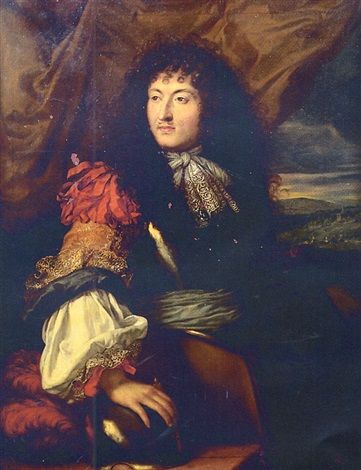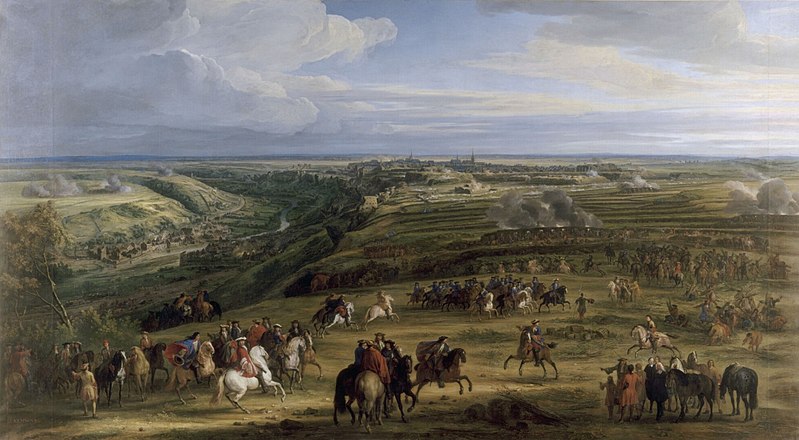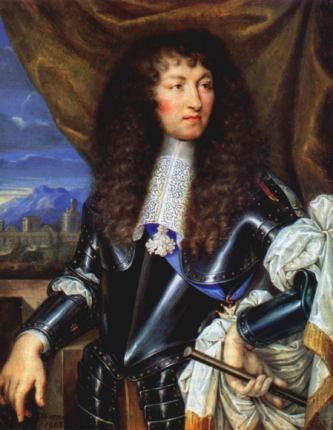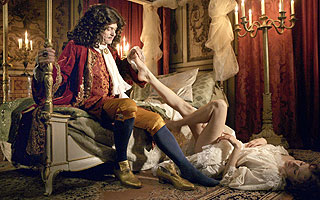The War of the Reunions, 1683-1684
The War of the Reunions was a short conflict in a larger conflict between France, the Republic of the Seven United Netherlands, Spain and the Holy Roman Empire. Some historians claim it was Louis XIV’s most successful war.

The whole thing already started in the 1670s. In several peace treaties, that of Westphalia, Aix-la-Chapelle and Nijmegen, France gained several territories. Not as much as Louis XIV would have liked to satisfy his excessive expansion politics, but among the territories gained were some strategically important places.
When cities changed hands, or rather ruler-ship, usually all areas providing for the city changed ruler-ship as well. As in: villages, mills, forests, rural areas and farmland. The borders of those areas were mostly not really defined… which led Louis XIV to set up an investigation about whether everything he thought should be his had actually been granted to him.
Louis set up several Chambres des Réunions, special courts, whose job it was to find out which of the dependencies were actually French now and if any that should be French now were not yet French. The Chambres des Réunions of course decided in favour of Louis XIV after reviewing documents dating back to the middle ages, which more or less granted the dependent territories to the new ruler.
The Sun King did not hesitate to lay claim to the territories in question, most were part of the Spanish Netherlands or under control of the Empire then. At the start it were only villages or small towns, so the previous owners sort of endured the annexations… but then Louis seized more important parts of Alsace and also wanted the cities Strasbourg and Luxembourg.
Strasbourg was a neutral and independent city… or was meant to be one. In the past it has served several times as gate for Imperial forces to France. Louis and his advisers figured that as long as Strasbourg was not under his rule, his seized Alsace territories would not be safe from attack. The same applied to Luxembourg, which was a threat to the seized lands in the Spanish Netherlands. Strasbourg was the first to fall, after Louis had it surrounded by his troops. He marched into the town on 30 September in 1681. Louis then sent Louis-François de Boufflers, known as the Chevalier Boufflers, to surround and begin an artillery and mortar barrage of Luxembourg.
Luxembourg was under control of the Spanish but belonged to the Empire… and the Empire had a bit of a problem at that time. The Ottomans were knocking at its gates and they were quite distracted by that. Louis sort of refused to get involved in the conflict, and behind closed doors encouraged the Ottomans, but considered it not to be good for his reputation as Christian King to attack a Christian city, while the Christian ‘owner’ of that city was busy with defending against a not-Christian army. He thus withdrew his forces from Luxembourg.

So, instead of bombarding Luxembourg, Louis got into contact with Emperor Leopold I to gain Luxembourg this way. Leopold was not willed to let Louis have his way. He teamed up with Brandenburg, German Princes, Sweden, the Netherlands and Spain and informed Louis he would march against him to restore the lands taken by Louis to their previous ruler.
The Emperor and his allies already made plans on how to do that, as the Ottomans reached Vienna and said plans had to be abandoned. Louis of course hoped the Ottomans would weaken the Emperor enough for him to have an easy game with him… but that did not really happen. The the Ottoman threat stalled before Vienna and Leopold was able to turn his attention back to Louis for a while. In the meanwhile, Louis had been busy with threatening Spain and the population of the Spanish Netherlands to pay contribuere, money and goods, to his troops. In turn Spain teamed up with the Netherlands, which Louis tried to avoid in vain. Spain then declared war on France on 26 October in 1683.
Louis le Grand sent Louis de Crévant, Duc d’Humière, to take the town of Courtrai in November, while François de Créquy was sent to bombard Luxembourg in December 1683. The bombardment lasted a couple of days, before Créquy withdrew for the winter… but the devastation caused by the French was great. Louis really wanted Luxembourg and to get it, he hoped that when his troops behave especially awful, the population of the area might pressure Spain into giving Louis what he wants. Fields were burned, estates destroyed, goods seized and the population forced to play high contribueres. On one occasion, Louvois ordered the Comte de Montal to burn twenty villages near Charleroi to the ground as reprisal for two burned French barns and Louis XIV apparently ordered de Humières to burn twenty houses for every destroyed French house.
As aggressive as Louis XIV was in this conflict, which swiftly gained the reputation of being especially bloody, he also sought to keep the conflict as small as possible. He offered Spain, in November 1683, to refrain from seizing more of the Spanish Netherlands, if they would grant Luxembourg to him. They refused. In February 1684, Louis offered a twenty-year peace, which he had also offered the Emperor the previous year. Both refused.
The real battle for Luxembourg started the next spring. After 6000 bombs and grenades had been fired on Luxembourg in December, François de Créquy managed to cut Luxembourg off from the main Spanish army in January 1684 and an army of 20000 men was posted between Brussels and Luxembourg, in order to distract the enemy troops from the actual objective. Sébastien Le Prestre de Vauban, a master of siege warfare and fortifications, headed to Luxembourg with another 25000 men. Luxembourg was defended by Spanish troops under command of the Prince de Chimay and the Comte de Tille and some local volunteers. All in all around 4000 men.
Defensive positions were built by the French all around the city, which took around 12000 workers, of which some were peasants and others were brought from Metz and Verdun. The Spanish, of course, tried to sabotage the structures. A major sorty on 1 May sent the workers running and the Spanish managed to destroy the defences, before they were sent running in turn by a French counter-attack.

Vauban inspected the area and decided a main point of attack, along with another possible one and planned distractions in form of feint attacks. Trenches were dug accordingly from early May on and the French advanced slowly but surely towards the city. During the siege, the French artillery bombarded the city day and night with more than 55000 shots. The Spanish fought vividly and bravely until 3 June, when it became clear to them that there was no hope of holding the city any longer.
After the city was captured, the French marched to Trier, where they took the city and destroyed the fortifications. Then they marched into the Electorate of Cologne, with the approval of its ruler. The Emperor assisted the Spanish with troops, but that was all he could do for the Ottoman situation became worse again.
At the same time as Luxembourg was under attack, the Republic of Genoa was also confronted with Louis’ wrath. While Genoese bankers lend Spain plenty of money in the past, their involvement in the current conflict was limited to the to recruitment of mercenaries by the Spanish on Genoese territory and building galleys for the Spanish navy. The Sun King did not like that the Genoese allowed the Spanish to use their port and sent a fleet their way. The French showered Genoa with 13300 bombs, destroying about two-thirds of the city.
Louis XIV had attained his war aim, namely Luxembourg, and now sought to negotiate peace. He managed to get the Netherlands to agree to a twenty year peace, against the will of the Stadtholder, in June and a truce with Spain followed in August. Spain had to give Luxembourg, Bovines, Chimay and Beaumont to Louis XIV. Courtrai and Dixmunde were returned to Spain and it was agreed that Louis could keep the rest of the seized lands, including Strasbourg, for twenty years… but this truce only lasted four years, before the Nine Years’ War (aka War of the Grand Alliance or the War of the League of Augsburg) swept over Europe and turned into a global war.




